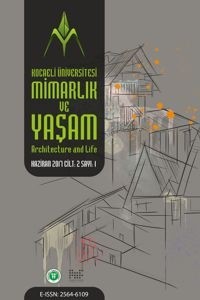Yeniden İşlevlendirilen Endüstri Mirası Yapılar için İç Mekân Kavramsal Önerileri
Endüstriyel Miras, Koruma, Mimari Süreklilik, Yeniden İşlevlendirme Tasarım Kriterleri, Çağdaş Yaklaşımlar
Interior Conceptual Suggestions for Re-functioned Industrial Heritage Buildings
Industrial Heritage, Conservation, Architectural Continuity, Re-Functioning Design Criteria, Contemporary Approaches,
___
- Acartürk, K. (2012). Türkiye’de fuarcılık ve fuarları coğrafi dağılımı. Coğrafya Dergisi, (25), 55-66.
- Adana Kültür ve Tabiat Varlıkları Koruma Kurulu Arşivi (AKTVKKA). (2009).
- Ahmeti, N. (2018). Adaptive Reuse of Heritage Buildings as a Tool to Integrate Conflicting Societies: Kosova Example. (Master thesis). Çankaya University/Institute of Natural and Applied Sciences, Ankara.
- Altınoluk, Ü. (1998). Binaların Yeniden Kullanımı, Program-Tasarım-Uygulama-Kullanım. İstanbul: Yem Yayınları.
- Bullen, P. A. & Love, P. E. D. (2009). Residential regeneration and adaptive reuse: Learning from the experiences of Los Angeles. Struct. Surv., 27, 351-360.
- Büyükaslan, B. & Güney, D. E. (2013). Endüstriyel Miras Yapılarının Yeniden İşlevlendirilme Süreci ve İstanbul Tuz Ambarı Örneği, Beykent Üniversitesi Fen ve Mühendislik Bilimleri Dergisi, Cilt 6(2), 31 – 58.
- Durna, K. Ç. (2019). Kullanım Dönüşümlerinin Sosyal Sürdürülebilirlik Boyutu: Bomonti Bira Fabrikası Örneği. (Yüksek lisans tezi). Yıldız Teknik Üniversitesi/Fen Bilimleri Enstitüsü, İstanbul.
- Eisenman, P. (2006). The Formal Basis of Modern Architecture. Zürih: Lars Müller Publishers.
- Erdin, E. H. & Kokum, O. (2006). Dünya fuarı olarak “EXPO”yu İzmir’de düşün(dür)mek. Planlama, (3), 59-66.
- Garstka, G. J. (2010). Post-conflict urban planning: The regularization process of an informal neighbourhood in Kosova. Habitat International, 34(1), 86-95.
- Gaziantep Ticaret Odası (GTO). (2012). https://www.gto.org.tr/
- Icomos (1999). Geleneksel Mimari Miras Tüzüğü.
- İstanbul Arkeoloji Müzesi Kütüphanesi Arşivi. Konstantinopolis Kenti Planı, 1855-63.
- Koçyiğit, G. R. (2018). Mark Augé’de yok-yer (non-lieu) kavramı üzerine bir epistemik çözümleme. Megaron, 13(4), 536-544.
- Kurak Açıcı, F. & Konakoğlu, Z. N. (2019). Tarihi yapıların yeniden işlevlendirilmesi: Trabzon Mimarlar Odası örneği. Eylül, Ç.Ü.Sosyal Bilimler Enstitüsü Dergisi, 28(2), 214-224.
- Kuban, D. (2000). Tarihi Çevre Korumanın Mimarlık Boyutu Kuram ve Uygulama. İstanbul: Yapı Endüstri Merkezi Yayınları.
- Mesutoğlu, Z. (1995). U. Tanyeli ile söyleşi. Arredamento Dekorasyon, (74), 64-69.
- Pervititch, J. (2000). Jacques Pervititch Sigorta Haritalarında. İstanbul: Tarih Vakfı.
- Sandal, K. E. & Şen, Ö. (2013). Gaziantep ilinin ekonomik coğrafyasından bir kesit: 1998-2012 yılları arası ihracat performansının istatiki verilerle analizi. Sosyal Bilimler Dergisi, 3(6), 44-45.
- Sevim, A. (2021). Fabrika’dan Ada’ya: Bomonti, 28 Ekim 2021. https://www.arkitera.co m/gorus/fabrikadan-adaya-bomonti/
- Şişli Belediyesi Arşivi.
- Tamer, Ü. (2020). Alleben Öyküleri. İstanbul:Ketebe Yayınevi.
- Tanyeli, G. (1998). Endüstri arkeolojisi. Arredamento Mimarlık, (92).
- Tanyeli G. & İkiz D. (2009). İstanbul’da bir endüstriyel miras örneği: Bomonti Bira Fabrikası. TÜBA-KED, (7), 109-121.
- Tülücü, A. T. (2007). Adana Kenti Tarihi Endüstri Yapılarının Yapısal Analizi ve Korunmaları İçin Yöntem Araştırması. (Doktora tezi). Gazi Üniversitesi/Fen Bilimleri Enstitüsü, Ankara.
- Internet References
- URL-1 https://www.mukamimarlik.com/bomonti-bira-fabrikasi
- URL-2 https://www.arkitera.com/gorus/fabrikadan-adaya-bomonti/
- URL-3 https://sehirharitasi.ibb.gov.tr/
- URL-4 http://Lvcmd.com.tr/tr-TR/projects/tuzambari-medina-turgul-ddb
- URL-5 http://www.arkiv.com.tr/proje/ddb-tuz-ambari/1455?lang=en
- URL-6 https://www.abamor.com.tr/icerik/1/hakkimizda,%20Date%20of%20Access:%20 20.01.2021
- URL-7 https://www.google.com/maps/place/Abamor+Sadeya%C4%9F/@37.1556264, 38.8073812,17z/data=!3m1!4b1!4m5!3m4!1s0x153471d5c467242f:0xee3c6c1b1613388e!8m2!3d37.1556264!4d38.8095699
- URL-8 http://wowturkey.com/forum/viewtopic.php?t=47965&start=10
- URL-9 https://frhyapi.com.tr/bizdetay/kulturpark-yozlastirildi/
- URL-10 https://www.facebook.com/birsevdadirgaziantep/photos/a.5134683587855 32/1998712583594428
- URL-11 https://www.trivago.com.tr/gaziantep-32196/otel/novotel-gaziantep-1448709
- URL-12 https://www.koray.com/forum-gaziantep-alisveris-merkezi
- URL-13 https://m.facebook.com/GAZIANTEPSIVESI/photos/gaziantep-fuar-y%C4%B1l 1963halit-ziya-bi%C3%A7er-objektif-ve-ar%C5%9Fivinden-seyr-i-antep/319196794086 2658/
- URL-14 http://wowturkey.com/forum/viewtopic.php?t=76263&start=20
- URL-15 http://wowturkey.com/forum/viewtopic.php?t=76263&start=25
- ISSN: 2564-6109
- Başlangıç: 2016
- Yayıncı: Kocaeli Üniversitesi
Safranbolu Eski Çarşı Bölgesinde Mekanın Tüketim Ekseninde İrdelenmesi
Sebile Merve ÖZTÜRK, Ruşen YAMAÇLI
Yerel Mimaride Değişimler/Dönüşümler: Sırt Mahallesi Örneği (Rize-İkizdere/Türkiye)
Biyomimetrik Yapı Malzemeleri ile Post Pandemik Döneme Uygun İç Mekanlar Tasarlanması
Ekolojik Binaların Sürdürülebilir Tasarım Kriterleri ve Değerlendirme Süreci
Ahmet Necip BELEK, Ruşen YAMAÇLI
Yüzen Evlerde Sürdürülebilirlik Kavramı
Filiz TAVŞAN, Sümeyye PERVANOĞLU, Cengiz TAVŞAN
Osmanlı İmparatorluğu’ndaki Demiryolu Seferberliğinin Konya Vilayeti Üzerindeki Kentsel Etkileri
Mimarlıkta Yapı Dersleri Müfredatı Dijital Dönüşüm Modeli
Tayibe SEYMAN GURAY, Burcu KISMET
İç Mimarlık Eğitiminde Sanal Gerçeklik Uygulamalarının Önemi
